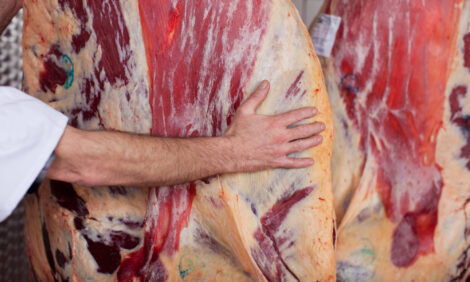



In The Cattle Markets: Supply & Demand Estimates
US - US Department of Agriculture's (USDA) World Agricultural Outlook Board released its supply and demand estimates last Thursday, revealing what many expected - a drop in US corn and soybean supplies due primarily to lower yields for both crops.Agricultural Supply and Demand Estimates
The crop has been hit with extreme heat in many predominant growing areas thus far this summer, which was exacerbated by the delayed plantings putting the plants at critical growth stages later than normal.
Average projected US corn yield was reduced from 158.7 bushels per acre in July to 153 bu/ac this month. Analysts expected a decline to 155.2 bu/ac.
Corn harvested acreage was also reduced marginally to 84.4 million from 84.9 last month, a 0.6 per cent decline, but up 3.7 per cent compared to last year.
Corn used for feed in the 2011/12 crop-marketing year is currently projected at 4.9 billion bushels versus 5.1 billion bushels going to ethanol production. This implies a near even split in uses for these two at just under 40 per cent each.
Exports were projected lower as well due to fragile global economic conditions and increased expectations of wheat feeding.
Collectively, these estimates put next year’s carry-over at 714 million bushels with a stocks-to-use ratio of 5.4 per cent, which if realised would be the second lowest in recent memory.
The lowest was the 1995/96 marketing-year when stocks fell to 426 million bushels as a result of much lower production – production in 1993 was markedly lower as well. Following the 1995 growing season, it took two years to push stocks back above the billion bushel mark but the dynamics of this market are much different today versus then.
The report came in the midst of a market free-for-all following the reduction in the US rating from Standard and Poor’s. Since Monday of last week, the Dow Jones Industrial Average has seen three negative move days and four positive move days, but the down days outweigh the up moves by about 40 points. These types of events will continue to weigh on beef demand both in domestic markets and overseas.
Speaking of demand, the Outlook Board’s projections for the beef industry showed a smaller forecasted per capita consumption number for this year and 2012. Lest we not forget that per capita consumption is not demand, per se, but it is an indicator of beef utilisation.
Offsetting the lower use of beef in the coming years is a year-over-year drop in production for 2010, 2011, and 2012. This reinforces the notion of tight supplies that continue to strengthen. Dry weather across many states in the southern US continues to force many to scale back. Total meat and poultry production if forecast to increase over the coming years but is down from the previous month’s estimates.
The Markets
Wholesale beef prices were higher last week. Choice and Select prices were up $3.24/cwt and $3.14/cwt finishing the week at $176.65 and $172.79, respectively.
Fed cattle were up on the week as well with the five-Area live price at $176.65/cwt, up just over five dollars, and the dressed price was up nine dollars at $184.77/cwt. Live sales in Texas sold at $116/cwt.
In Nebraska, live cattle mostly sold from $116-$117, while dressed sales were at $185/cwt. Feeder steers in Oklahoma were up and down on the week, but feeders finished up two dollar/cwt and calves were unevenly steady. Omaha corn prices were up sic cents from the previous week at $7.20/bu.
Despite the turmoil in the equity markets, futures were higher for both cattle and corn on the week. Corn futures received a boost Thursday as a result of the WASDE report and cattle moved higher due to stronger cash and beef prices.


